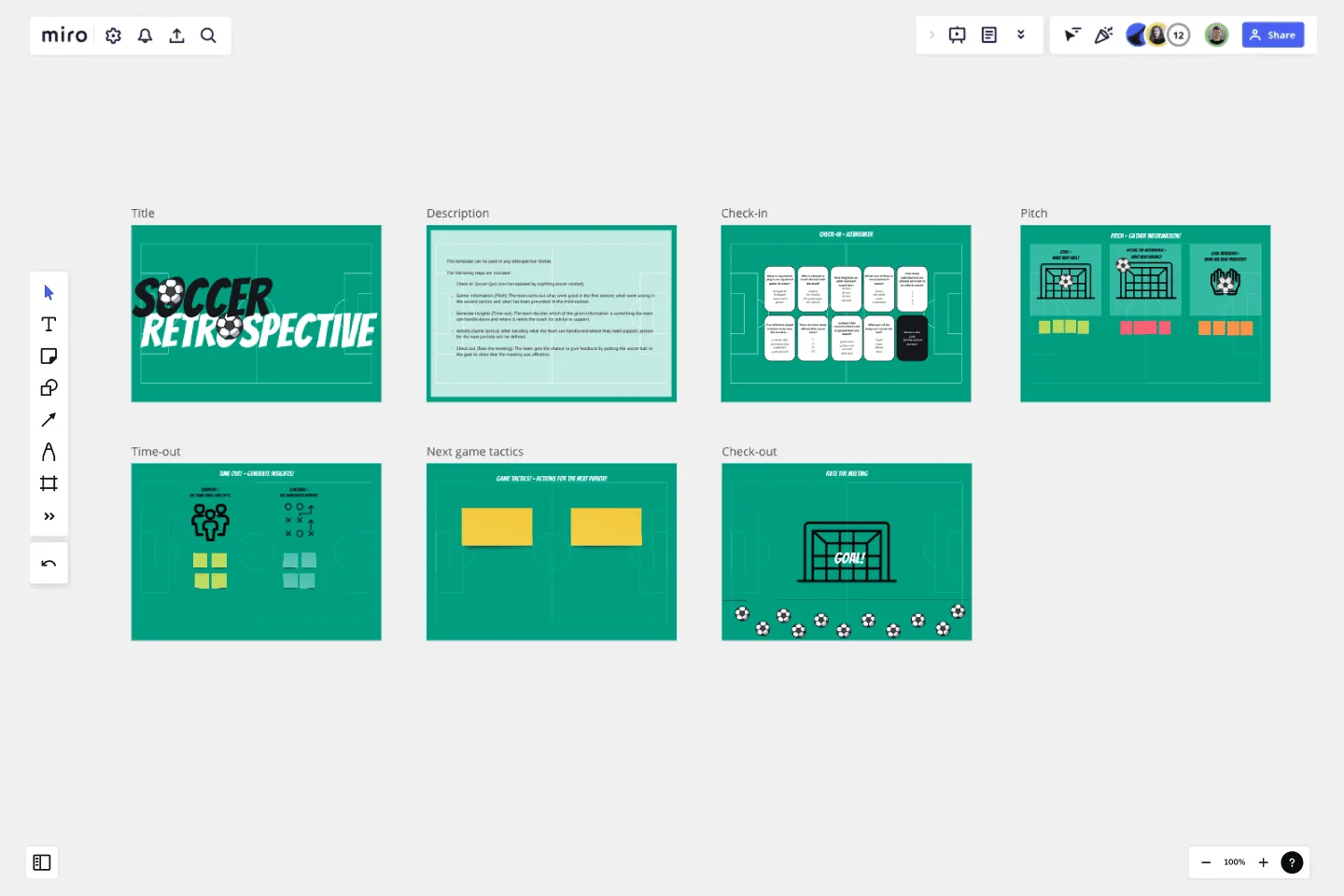Soccer Retrospective
This is a 60-90 minute retrospective inspired by soccer.
The goal of this retrospective is to help team members look back at a Sprint, project or a periode in general and evaluate what went well, what went not well and what was prevented.
How to use this template
This template can be used in a team from 2 to 9 people or even bigger teams. Just copy or remove icons to fit it to your team size.
Check-in: Just start with a check in of your choice or use the soccer quiz.
Gather information: With the three spaces for what went well, what went not well and what was pevented.
Generate insights: With the two spaces to decide what the team can handle alone without support and where the team needs support or advice from the coach.
Actions: Decide which actions are needed for the next periode.
Check-out: Let the team decide if the meeting has scored a goal.
This template was created by Daniel Fischer.
Get started with this template right now.
SAFe PI Planning
Works best for:
Agile
SAFe PI Planning is a collaborative event for Agile Release Trains to plan and align on program increments. It provides a structured framework for setting objectives, identifying dependencies, and sequencing work. This template facilitates PI Planning sessions, enabling teams to visualize their commitments and coordinate cross-team dependencies effectively. By promoting transparency and alignment, SAFe PI Planning empowers Agile organizations to deliver value at scale with predictability and quality.
SaaS Implementation Timeline
Works best for:
Agile
The SaaS Implementation Timeline template offers a visual roadmap for planning and tracking the implementation of Software as a Service (SaaS) solutions. It provides a structured framework for defining milestones, allocating resources, and monitoring progress. This template enables organizations to manage SaaS deployments effectively, ensuring successful adoption and realization of business value. By promoting transparency and accountability, the SaaS Implementation Timeline empowers teams to deliver projects on time and within budget, driving organizational agility and competitiveness.
DevOps Roadmap Template
Works best for:
Documentation, Product Management, Software Development
DevOps teams are constantly creating code, iterating, and pushing it live. Against this backdrop of continuous development, it can be hard to stay abreast of your projects. Use this DevOps Roadmap template to get a granular view of the product development process and how it fits into your organization's product strategy. The DevOps Roadmap lays out the development and operations initiatives you have planned in the short term, including milestones and dependencies. This easy-to-use format is easily digestible for audiences such as product, development, and IT ops.
What's on Your Radar Template
Works best for:
Business Management, Operations, Strategic Planning
Do you or your team feel overburdened by tasks? Having trouble focusing on particular problems? What’s on Your Radar is a thought exercise in which you plot ideas according to their importance or relevance. Designers and teams use what’s on your radar to ensure that their ideas are within the scope of a given project. They also rely on the method to assess whether a given solution is likely to solve the problem at hand. But even if you’re not a designer, the method can help assign priorities and ground your ideas in reality.
Sprint Review Template
Works best for:
Sprint Review, Agile
The Sprint Review Template is a vital tool in Agile project management that enhances communication between team members and stakeholders by providing a clear format for presenting the sprint's accomplishments and challenges. It encourages active participation and feedback from all attendees, leading to more informed decision-making and continuous improvement. In essence, it's a catalyst for meaningful dialogue and collaborative growth.
PI Planning Template
Works best for:
Agile Methodology, Strategic Planning, Software Development
PI planning stands for “program increment planning.” Part of a Scaled Agile Framework (SAFe), PI Planning helps teams strategize toward a shared vision. In a typical PI planning session, teams get together to review a program backlog, align cross-functionally, and decide on the next steps. Many teams carry out a PI planning event every 8 to 12 weeks, but you can customize your planning schedule to fit your needs. Use PI planning to break down features, identify risks, find dependencies, and decide which stories you’re going to develop.

